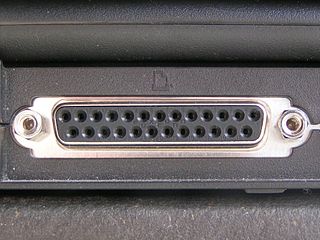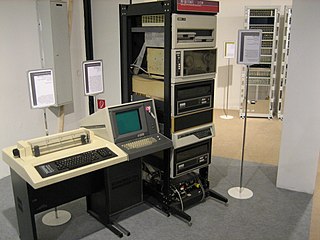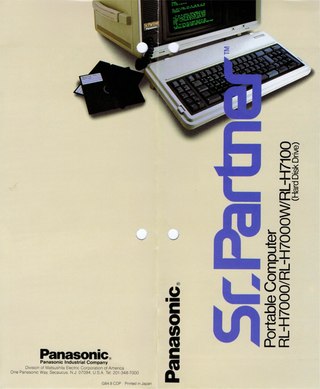
In the field of computing, a printer is considered a peripheral device that serves the purpose of creating a permanent representation of text or graphics, usually on paper. While the majority of outputs produced by printers are readable by humans, there are instances where barcode printers have found a utility beyond this traditional use. Different types of printers are available for use, including inkjet printers, thermal printers, laser printers, and 3D printers.

A line printer prints one entire line of text before advancing to another line. Most early line printers were impact printers.

Dot matrix printing, sometimes called impact matrix printing, is a computer printing process in which ink is applied to a surface using a relatively low-resolution dot matrix for layout. Dot matrix printers are a type of impact printer that prints using a fixed number of pins or wires and typically use a print head that moves back and forth or in an up-and-down motion on the page and prints by impact, striking an ink-soaked cloth ribbon against the paper. They were also known as serial dot matrix printers. Unlike typewriters or line printers that use a similar print mechanism, a dot matrix printer can print arbitrary patterns and not just specific characters.
Control Data Corporation (CDC) was a mainframe and supercomputer company that in the 1960s was one of the nine major U.S. computer companies, which group included IBM, the Burroughs Corporation, and the Digital Equipment Corporation (DEC), the NCR Corporation (NCR), General Electric, and Honeywell, RCA and UNIVAC. For most of the 1960s, the strength of CDC was the work of the electrical engineer Seymour Cray who developed a series of fast computers, then considered the fastest computing machines in the world; in the 1970s, Cray left the Control Data Corporation and founded Cray Research (CRI) to design and make supercomputers. In 1988, after much financial loss, the Control Data Corporation began withdrawing from making computers and sold the affiliated companies of CDC; in 1992, Cray established Control Data Systems, Inc. The remaining affiliate companies of CDC currently do business as the software company Ceridian.

Daisy wheel printing is an impact printing technology invented in 1970 by Andrew Gabor at Diablo Data Systems. It uses interchangeable pre-formed type elements, each with typically 96 glyphs, to generate high-quality output comparable to premium typewriters such as the IBM Selectric, but two to three times faster. Daisy wheel printing was used in electronic typewriters, word processors and computers from 1972. The daisy wheel is so named because of its resemblance to the daisy flower.

In computing, a parallel port is a type of interface found on early computers for connecting peripherals. The name refers to the way the data is sent; parallel ports send multiple bits of data at once, as opposed to serial communication, in which bits are sent one at a time. To do this, parallel ports require multiple data lines in their cables and port connectors and tend to be larger than contemporary serial ports, which only require one data line.

The Amstrad PCW series is a range of personal computers produced by British company Amstrad from 1985 to 1998, and also sold under licence in Europe as the "Joyce" by the German electronics company Schneider in the early years of the series' life. The PCW, short for Personal Computer Word-processor, was targeted at the word processing and home office markets. When it was launched the cost of a PCW system was under 25% of the cost of almost all IBM-compatible PC systems in the UK, and as a result the machine was very popular both in the UK and in Europe, persuading many technophobes to venture into using computers. The series is reported to have sold 1.5 million units. However the last two models, introduced in the mid-1990s, were commercial failures, being squeezed out of the market by the falling prices, greater capabilities and wider range of software for IBM-compatible PCs.

IEEE 1284, also known as the Centronics port, is a standard that defines bi-directional parallel communications between computers and other devices. It was originally developed in the 1970s by Centronics before its IEEE standardization.

In data transmission, parallel communication is a method of conveying multiple binary digits (bits) simultaneously using multiple conductors. This contrasts with serial communication, which conveys only a single bit at a time; this distinction is one way of characterizing a communications link.

Floating Point Systems, Inc. (FPS), was a Beaverton, Oregon vendor of attached array processors and minisupercomputers. The company was founded in 1970 by former Tektronix engineer Norm Winningstad, with partners Tom Prince, Frank Bouton and Robert Carter. Carter was a salesman for Data General Corp. who persuaded Bouton and Prince to leave Tektronix to start the new company. Winningstad was the fourth partner.
The TallyGenicom brand, acquired by Printronix in 2009, includes laser and line matrix printers, parts, consumables and service. Printronix now owns the intellectual property and worldwide sales distribution rights for TallyGenicom line matrix and laser technologies, including printers, supplies and consumables. TallyGenicom AG retained all intellectual property and worldwide distribution rights for the TallyGenicom serial matrix, inkjet and thermal technologies, including printers and options, supplies and consumables.
The Actrix computer, released in 1983 by Actrix Computer Corporation, was a Zilog Z80-based transportable personal computer running CP/M-80 V2.2. It was initially released as the Access Computer, made by Access Matrix Computer Corporation, but both the company and its product changed names after trademark disputes.
GENICOM was an American manufacturer of computer printers, based in Chantilly, Virginia. The company operated from 1982 to 2003.

Tally was a leading American manufacturer of printers.
Pertec Computer Corporation (PCC), formerly Peripheral Equipment Corporation (PEC), was a computer company based in Chatsworth, California which originally designed and manufactured peripherals such as floppy drives, tape drives, instrumentation control and other hardware for computers.
A SCSI connector is used to connect computer parts that use a system called SCSI to communicate with each other. Generally, two connectors, designated male and female, plug together to form a connection which allows two components, such as a computer and a disk drive, to communicate with each other. SCSI connectors can be electrical connectors or optical connectors. There have been a large variety of SCSI connectors in use at one time or another in the computer industry. Twenty-five years of evolution and three major revisions of the standards resulted in requirements for Parallel SCSI connectors that could handle an 8, 16 or 32 bit wide bus running at 5, 10 or 20 megatransfer/s, with conventional or differential signaling. Serial SCSI added another three transport types, each with one or more connector types. Manufacturers have frequently chosen connectors based on factors of size, cost, or convenience at the expense of compatibility.

The DECwriter series was a family of computer terminals from Digital Equipment Corporation (DEC). They were typically used in a fashion similar to a teletype, with a computer output being printed to paper and the user inputting information on the keyboard. In contrast to teletypes, the DECwriters were based on dot matrix printer technology, one of the first examples of such a system to be introduced. Versions lacking a keyboard were also available for use as computer printers, which eventually became the only models as smart terminals became the main way to interact with mainframes and minicomputers in the 1980s.
CARDCO was a computer peripheral company during the 1980s in Wichita, Kansas, United States. CARDCO was well known in the Commodore 64 and VIC-20 community because of advertisements in numerous issues of Compute! magazine and availability of their products at large retailers, such as Target.

The Senior Partner is an IBM PC-compatible portable computer that was introduced by the Panasonic Corporation in 1984. Weighing roughly 31 pounds (14 kg) in its base configuration, the computer came equipped with a cathode-ray tube display and a built-in thermal printer.
The Xerox 2700 is a discontinued monochrome laser printer from Xerox Corporation. The 2700 was announced in March, 1982, and can print up to 12 pages per minute (PPM), one-sided, on standard A4 or Letter cut-sheet paper. It occupies 5 square feet (0.46 m2) of floor space, and cost $18,995. The 2700 is rated for a print volume of 15,000 pages per month, although some users got up to 100,000 pages.











